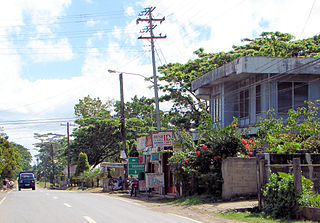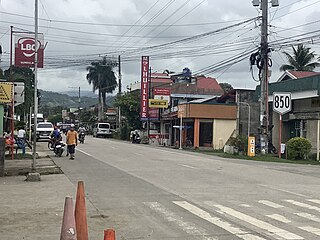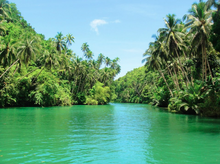
Bohol, officially the Province of Bohol, is an island province of the Philippines located in the Central Visayas region, consisting of the island itself and 75 minor surrounding islands. Its capital is Tagbilaran. With a land area of 4,821 km2 (1,861 sq mi) and a coastline 261 km (162 mi) long, Bohol is the tenth largest island of the Philippines.

Siquijor, officially the Province of Siquijor, is an island province in the Philippines located in the Central Visayas region. Its capital is the municipality also named Siquijor. To the north of Siquijor is Cebu, to the west is Negros, northeast is Bohol, and to the south, across the Bohol Sea, is Mindanao.

Batuan, officially the Municipality of Batuan, is a 5th class municipality in the province of Bohol, Philippines. According to the 2020 census, it has a population of 13,845 people.

Cortes, officially the Municipality of Cortes, is a 5th class municipality in the province of Bohol, Philippines. According to the 2020 census, it has a population of 18,344 people.

Lila, officially the Municipality of Lila, is a 5th class municipality in the province of Bohol, Philippines. According to the 2020 census, it has a population of 12,240 people.

Loay, officially the Municipality of Loay, is a 5th class municipality in the province of Bohol, Philippines. According to the 2020 census, it has a population of 17,855 people.

Loboc, officially the Municipality of Loboc, is a 4th class municipality in the province of Bohol, Philippines. According to the 2020 census, it has a population of 17,418 people.

Loon, officially the Municipality of Loon, is a 2nd class municipality in the province of Bohol, Philippines which was established in 1753. According to the 2020 census, it has a population of 44,224 people.

Sikatuna, officially the Municipality of Sikatuna, is a 5th class municipality in the province of Bohol, Philippines. According to the 2020 census, it has a population of 6,906 people.

Talibon, officially the Municipality of Talibon, is a 1st class municipality in the province of Bohol, Philippines. According to the 2020 census, it has a population of 71,272 people.
The legislative districts of Bohol are the representations of the province of Bohol in the various national legislatures of the Philippines. The province is currently represented in the lower house of the Congress of the Philippines through its first, second, and third congressional districts.

The 2013 Bohol earthquake occurred on October 15 at in Bohol, an island province located in Central Visayas, Philippines. The magnitude of the earthquake was recorded at 7.2, with epicenter 6 kilometres (3.7 mi) S 24° W of Sagbayan, and its depth of focus was 12 kilometres (7.5 mi). It affected the whole Central Visayas region, particularly Bohol and Cebu. The earthquake was felt in the whole Visayas area and as far as Masbate island in the north and Cotabato provinces in southern Mindanao.

The San Pedro Apostol Parish Church, commonly known as Loboc Church, is a Roman Catholic church in the municipality of Loboc, Bohol, Philippines, within the jurisdiction of the Roman Catholic Diocese of Tagbilaran.

The Rajah Sikatuna Protected Landscape is a protected landscape area of forested limestone hills, grasslands and natural springs in the island province of Bohol in the Central Visayas region of the Philippines. It is the largest remaining tract of natural forest in Bohol and one of the Philippines' top birdwatching sites. The park was initially gazetted a national park in 1987 covering approximately 9,023 hectares. In 2000, it was reestablished as a protected landscape under the National Integrated Protected Areas System covering its present area of 10,452.6 hectares. The park is one of the island's major tourist attractions located just south of the famous Chocolate Hills. It was named after the Bohol chieftain who entered into a blood-compact with Spanish conquistador Miguel López de Legazpi on the island in 1565.

The Abatan River is a river in western Bohol, Philippines. The river winds through the towns of Catigbian, Antequera, Balilihan, and Maribojoc to its mouth at Cortes.

The Inabanga River is the largest river in Bohol, Philippines. It is 25 kilometres (16 mi) long and up to 7 to 10 metres deep at its mouth at the town of Inabanga.

Bohol's 3rd congressional district is one of the three congressional districts of the Philippines in the province of Bohol. It has been represented in the House of Representatives of the Philippines since 1916 and earlier in the Philippine Assembly from 1907 to 1916. The district consists of the southeastern municipalities of Alicia, Anda, Batuan, Bilar, Candijay, Carmen, Dimiao, Duero, Garcia Hernandez, Guindulman, Jagna, Lila, Loay, Loboc, Mabini, Pilar, Sevilla, Sierra Bullones and Valencia. It is currently represented in the 19th Congress by Alexie Tutor of the Nacionalista Party (NP).

The Loay Interior Road is a 78.92-kilometer (49.04 mi), two lane national secondary road that connects the municipality of Loay to the municipality of Trinidad in Bohol, Philippines. This highway serves as one of the principal gateways to Carmen, which is known for being the main location and tourist spot of the Chocolate Hills.

National Route 850 (N850) is a 260.25 km (161.71 mi), two-four lane, circumferential national secondary route that forms part of the Philippine highway network. It connects the whole island of Bohol. The route is composed of Tagbilaran North Road from Tagbilaran to Trinidad and Tagbilaran East Road from Trinidad to Tagbilaran again.





















